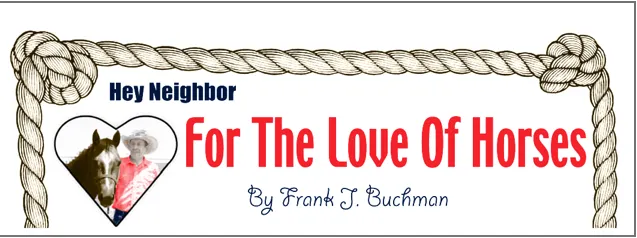For The Love Of Horses
By Frank J. Buchman
Cancelation Of State’s Biggest Attraction
Puts Kansas State Fair In Financial Bind
“We did not have a Kansas State Fair this year.”
David Tobias, interim general manager of the state’s biggest annual event at Hutchinson, was most emphatic reiterating the fact.
Like many activities throughout the world, the state fair was canceled due to coronavirus health concerns.
However, the elaborate state fairgrounds facilities still must be sustained without the annual income to do so.
Two hundred eighty acres comprise the Kansas State Fairgrounds including 70 buildings all together maintained by 26 employees.
Contrary to common belief, the state of Kansas provides no fiscal appropriations for this facility which represents a state entity. The Kansas State Fair is a separate body unrelated to any state programs.
“The Kansas State Fair is a fee-funded agency. We do not get funding from the state,” Tobias clarified.
Upon cancelation of the state fair two months ago, the former general manager resigned. With 9½-years’ experience working for the Kansas State Fair, Tobias was then appointed to the interim position.
Since 2018 legislative action, the fair does get a percentage of state sales tax generated on the grounds, Tobias noted.
“We live by concert tickets, gate admissions, vendor rentals, sponsorships, and competitive entries. Obviously that has all been very little this year,” Tobias said. “About 90 percent of our income is from fair-time revenue in 10 days, with the rest from non-fair building rentals.
“Due to the fair cancellation and lack of anticipated revenue, the fair’s current operating shortfall is $2.3 million,” Tobias said.
“In clarification the Kansas State Fair celebrates the best of Kansas communities, commerce, youth and food,” said Amy Bickel.
“It’s also the largest gathering of Kansans every September since the first official fair in 1913,” the marketing director explained. “This is the first year the state fair has been canceled.”
It survived through the Spanish Flu pandemic of 1918. Nearly canceled in 1945 due to World War II, the war ended during August and the fair continued.
According to a 2018 Department of Agriculture report, the fair has a $74.6 million annual impact on the Kansas economy. There’s a $40 million-plus impact to a 60-mile radius around Hutchinson, Tobias pointed out.
“We have contacted Commerce Secretary David Toland, who indicated we need to work with Washington to secure funding,” Tobias said.
“The International Association of Fairs and Expositions has spearheaded legislation for $500 million to help preserve the fair,” he added.
“We are also looking at micro events that could help generate some funding,” Bickel said.
While there was not a Kansas State Fair, livestock competitions did continue, according to Jenn Galloway, livestock events coordinator.
Youth including 4-H and FFA members work all year on projects to exhibit at Hutchinson’ Kansas State Fair during September.
“The Grand Drive weekend, our premier youth livestock show, attracts more than 800 youth exhibitors and 3,000 entries,” Galloway said.
More than 10,000 youth projects are entered annually at the Kansas State Fair. In 2019, that included 2,200 photography exhibits, 935 rabbits and 1,616 food entries.
“In 2020, we still hosted live the 4-H horse show, the Grand Drive, poultry, dairy cattle and dairy goat shows,” Galloway noted. Virtual static competitions were conducted for other youth projects.
“In a normal year, we have 4,800 open exhibitors, including both livestock and static entries,” Galloway said. Only 1,300 open exhibitors participated this year because there were no static entries such as baking, gardening and quilts.
“However, in the open livestock division, 652 cattle were exhibited, the most ever, and double a normal year,” Galloway said.
“Traditionally nearly 700 vendors rent space to promote their products at the Kansas State Fair. About 85 percent of them are from Kansas,” Bickel said.
“Facing unparalleled challenges, our fulltime staff remains committed to do everything they can to continue the longstanding celebration,” Tobias said. “We all hope the fair will sustain these unprecedented times and hope to bring the tradition back in 2021.”
The Kansas Fairgrounds Foundation is a 501(c)(3) nonprofit organization dedicated to supporting special needs for the fair. “That group is offering financial assistance at this time,” Tobias credited.
Donations can be made to the Kansas Fairgrounds Foundation, 2000 North Poplar, Hutchinson, Kansas, 67502. “Entire amount of donations goes to the Kansas State Fair,” Tobias promised.
The “Kansas Cares About The Fair 2020” campaign was developed to help in this time of need,” according to Bickel. “Individuals can give online at KansasStateFair.com by clicking donate.
“All funds go entirely to the Kansas State Fair. Your gift, large or small, will help secure the future of the Kansas State Fair for generations to come,” Bickel said. “We continue ‘Celebrating All Things Kansas’ until we meet again. Stay strong, Kansas.”
CUTLINES
Carnival attractions traditionally light up the sky while being an important part of raising funds for the Kansas State Fair at Hutchinson. There were no carnival or commercial vendors this year hampering financial status of the fair.
While there was not a “Kansas State Fair at Hutchinson this year, many livestock competitions did go on. The 4-H division attracted more than 120 horse exhibitors one of the largest 4-H horseshows ever at the fairgrounds. With more than 30 entries in a number of classes, the young exhibitors shown warming their horses up were enthusiastic competing for highpoint buckles presented by the Kansas Horse Council





